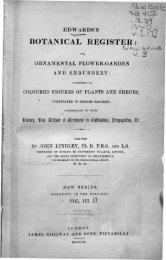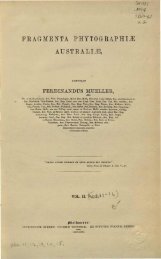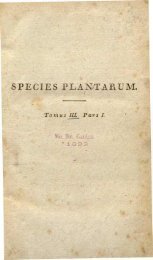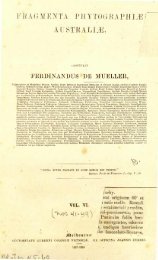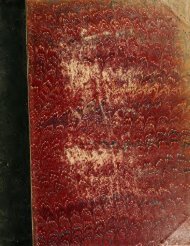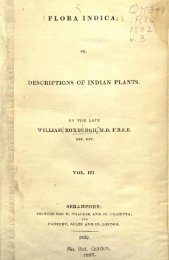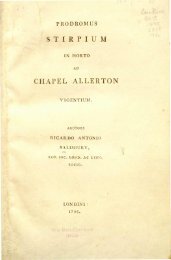Botanical Magazine 106 - 1880.pdf - hibiscus.org
Botanical Magazine 106 - 1880.pdf - hibiscus.org
Botanical Magazine 106 - 1880.pdf - hibiscus.org
You also want an ePaper? Increase the reach of your titles
YUMPU automatically turns print PDFs into web optimized ePapers that Google loves.
I am unable from the descriptions to refer it altogether<br />
satisfactorily to any described species. Of these, only one<br />
of the species with racemose inflorescence has been hitherto<br />
well figured, namely, that referred (t. 2932) to Swartz's<br />
Pontederia azurea (which is also figured in Martius' " Nova<br />
Genera et Species," as P. crassipes, Martius). This Kunth<br />
considers not to be Swartz's plant, and makes a new species<br />
of it ; E. speciosa, Kth. In so doing he is very probably<br />
justified, though it is to be regretted that he did not retain<br />
Martius' characteristic name of crassipes, especially as he<br />
quotes that author's description and figure. Swartz's P.<br />
azurea, then, is Kunth's Eichornia azurea, and the doubt<br />
in my mind is whether the subject of the present plate is<br />
referable to it. On the one hand, it appears to agree with<br />
a specimen of the only Jamaica species known to me which<br />
could be considered as Swartz's azurea, gathered by Purdie,<br />
and which Grisebach considers the true one ; on the other<br />
hand, neither Swartz, nor P. Browne in his full description,<br />
alludes to the beautifully-toothed inner perianth segment<br />
of our plant, nor can the latter author's description of the<br />
stamens be regarded as quite satisfactory : " filamenta . . 3<br />
superiora ad basim tubo adnata ; 3 inferiora in fundo floris<br />
sita." Browne adds, " I observed this plant in most of<br />
the Lagoons about the Ferry ; " and Purdie's ticket bears<br />
" Habitat, behind the Ferry," which must be regarded as<br />
settling the point in the present state of our knowledge.<br />
The figure cited of Schlechtendahl, appears to represent<br />
a larger-flowered plant than this, with flowers not in pairs,<br />
almost orbicular-obovate, much larger inner perianth lobes,<br />
and the eye-like spot rounded.<br />
E. azurea is, as far as can be ascertained by a comparison<br />
of dried specimens, a common tropical South American<br />
water-plant, extending from South Brazil to Jamaica ; it<br />
varies greatly in the size and form of the leaves and length<br />
of the petiole, and is found either floating, or rooted and<br />
erect in the muddy bottom of shallow water. It was<br />
introduced into the gardens of the Royal Botanic Society,<br />
Regent's Park, from Brazil, and flowered there in July of<br />
last year, and I am indebted to Mr. Sowerby for the plant<br />
here figured.<br />
DESCR. Stems as thick as the thumb, floating and rooting,<br />
green, smooth, flexuous. Leaves on long or short petioles,




